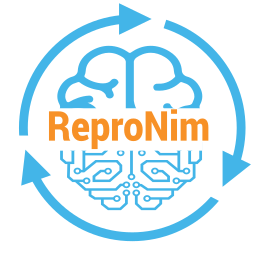Overview
Teaching: 10 min
Exercises: 0 minQuestions
Who is this module for ?
How can I get some help if I get stuck while solving an exercise or a question ?
How can I validate this module ?
Objectives
Teach neuroimagers about the statistical aspects of reproducibility
Have a collaborative training enterprise: you can improve this module if you know how to do a pull request or raise an issue on github:github.com/repronim/module-stat. See module ‘the informatics basics of reproducibility (module 0) on how to do this.
This module should give you a critical eye on most of the current literature and the knowledge to do statistically robust work, hence more replicable
What is a ReproNim module ?
A ReproNim module (or course) is a set of lessons (or “episodes”), in which we have gathered material from the web to guide you through the acquisition of a concept or tool or technique. You will take this journey and for each episode, we try to then ask you a few questions or do some exercise so that you will have an idea of how comfortable you are with the material. We are not providing the answers directly on this web site so that this can be taken as a real course, but we will be teaching workshops with the answers and we will have links to the answers.
Who is this statistical module for?
The module is intended for people working with neuroimaging data who want to know about the statistical aspects of reproducibility. You don’t need to be a statistician or applied mathematician to work sufficiently with neuroimaging data. However, the statistical analyses are an important part of any neuroimaging study and tremendously affect the results and thus their interpretation. Ensuring reproducible statistics is therefore a crucial aspect.
How much time this should take me?
That really depends on your familiarity with statistical concepts and your capacity to play with a few formulas and some code. If you have no familiarity at all, this may take you a long time; for instance, 5 to 7 full days. If you have good familiarity, some of the information will be already partially known and it may take you a full day to go through this material in detail.
What are the episodes for this module?
- Lesson 1: Statistical basis for reproducible neuroimaging
- Lesson 2: Effect size and variation of effect sizes in brain imaging
- Lesson 3: P-values and their issues
- Lesson 4: Statistical power in neuroimaging and statistical reproducibility
- Lesson 5: Positive predictive values
Do I need to code? What language?
You can learn a lot without coding, but you will have the full benefit if you do. So, yes, you should code. We have (mostly) adopted Python for this module. It may not be your first choice but we think some knowledge of Python coding will help you anyways. We will try to help as much as possible by providing tutorials, examples, and links to installation instructions.
ReproNim is truly open
The ReproNim training events can only accommodate a limited number of participants. Nevertheless, we are committed to openness and we are committed to providing our materials in an open format, with liberal licenses, and through a publicly-accessible website. We may occasionally refer to an article that is behind a paywall. If your institution or university does not give you access to it, let us know and we can provide a private copy for your personal use.

Exercises and challenges (click on the arrow to the right to open)
Callouts
We sometimes will have box with a “callout”, for extra material that is “optional”.
Key Points
Reproducible analysis is strongly impacted by statistical analyses.
Reproducible research requires understanding the notions of sampling, testing, power, model selection.